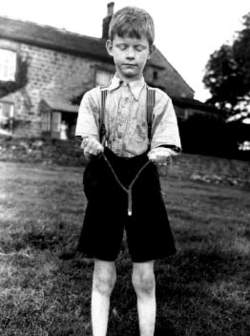divining rod
[də′vīn·iŋ ‚räd]Divining Rod
(religion, spiritualism, and occult)Divining rods were used by the ancient Greeks, Romans, Persians, and Scythians to discover the location of water or of various minerals. Basically a forked or Y-shaped stick, the hazel twig seems to have been the favorite, especially for finding water. For finding metals, popular woods were: hazel for silver, iron and steel for gold, ash for copper, and pitch pine for lead and tin. Other popular general purpose sticks are of ash, rowan, or willow.
The method is for the operator to hold the two ends of the stick in his or her hands and to walk over the area thought to be the probable source for the water or mineral. As the operator crosses the underground source, the twig will twist in the hands, often with such force that any bark may be stripped from the wood. In the Bible, Moses dowsed for water in the desert, using his staff as a divining rod (Exodus 17; Numbers 20). Marco Polo found rods in use throughout the orient in the late thirteenth century. Georg Agricola gave the first printed description of a dowsing or divining rod in his book De re metallica (Basel, 1556). Agricola’s interest was primarily with mining and locating minerals, but the techniques he describes are the same as those used for water divining or water witching. A well known illustration from his book shows a variety of men both digging and walking about with Y-shaped rods in their hands. One man is in the act of cutting a forked branch from a tree.
In Sebastian Münster’s Cosmographia universalis (Basel, 1544), there is an illustration of a man divining with a forked stick and showing a cross-section of the ground beneath him, where miners are at work. There is a bas relief in the Shantung Province of China showing Yu, a “master of the science of the earth and in those matters concerning water veins and springs.” He is shown holding a forked instrument.
Modern dowsers have developed such sensitivity and skill that they are able to measure the actual depth at which the substance will be found and, in the case of water, the rate of flow. According to the British Society of Dowsers, although no thorough scientific explanations for dowsing have yet been found, it is generally acknowledged that there is some correlation between the dowsing reaction and changes in the magnetic flux of the site being dowsed. In 1910, German scientist Baron Karl von Reichenbach said that the movement of the rod was due to earth force fields sending out radiations and vibrations which are picked up by the dowser.
As well as branches, many dowsers today use tools as varied as bent wire coat hangers, pendulums (with cavities for a “witness”—samples of what is being sought), and commercially produced, swinging rods especially designed for the purpose. Many modern well-drilling companies employ a diviner, or dowser, on their force. Some even guarantee that if they can’t find water, there will be no charge.
Dowsers have been widely employed around the world. The Government of India had an official Water Diviner who, between 1925 and 1930, traveled thousands of miles and located numerous wells and bore holes. In more recent years, the British Society of Dowsers had one of their experts go to southern India, where he sited boreholes for more than 1,800 previously dry villages.
As with any form of psychic or mediumistic skill, everyone has within them the inherent ability. But as with any other psychic skill, it is by practice and constant use that that skill is developed. As with so much in the field of psychic and mediumistic development, young children seem to be able to draw upon the skill much more easily and naturally than do adults.
Sources:
